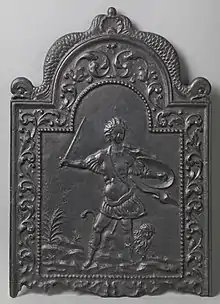Lion of Cithaeron
The Lion of Cithaeron[lower-alpha 1] was a lion in Greek mythology which was harassing the lands of king Amphitryon and king Thespius or of king Megareus. Some myths say that it was killed by Heracles, while others say it was slain by Alcathous of Elis.[1][2][3]

According to the Suda, it was also called the Thespian lion and the Ravine lion (Ancient Greek: Χαραδραῖος λέων, Charadraios leōn) because it lived in a place called "Ravine" (χαράδρα, charadra).[4]
Heracles
One account of the myth has it that king Thespius asked Heracles to kill the lion. Heracles hunted it for fifty days and finally killed it. During each night of the hunt, Heracles slept with a different daughter of the king; they each gave birth to a son. After he slew the animal, Heracles dressed himself in the skin of the animal and wore the scalp as a helmet. According to the Suda, it was killed near Thespiae. Heracles killed the lion while he was eighteen years old, and before killing the Nemean lion.[1][4]
Alcathous
According to Pausanias, writing in the second century BC, the Megarians believed that the Cithaeronian Lion killed many people, including Euippus, the son of their king Megareus. Consequently, Megareus promised that whoever killed the Lion would marry his daughter and inherit his throne. Alcathous killed the lion and when he became the king, he built the temple of Artemis Agrotera (Huntress) (Ancient Greek: Ἀγροτέραν Ἄρτεμιν) and Apollo Agraeus (Hunter) (Ancient Greek: Ἀπόλλωνα Ἀγραῖον).[2][3]
Notes
- Which is also spelled Kathairon, and the beast is thus sometimes called the Lion of Kathairon.
References
- Pseudo-Apollodorus. "4". The Library. Vol. 2. pp. 10–11.
- Pausanias. "41". Ἑλλάδος Περιήγησις [Description of Greece] (in Ancient Greek). Vol. 1. pp. 3–6.
- William Smith (1873). "Agraeus". A Dictionary of Greek and Roman biography and mythology. London.
{{cite book}}: CS1 maint: location missing publisher (link) - Suda. pp. chi.88.
- Gantz, Timothy (1993). Early Greek Myth: A Guide to Literary and Artistic Sources. Johns Hopkins University Press. p. 379. ISBN 0-8018-4410-X.
- Griffiths, Alan H. (2015). "Alcathous". Oxford Research Encyclopedia of Classics. doi:10.1093/acrefore/9780199381135.013.258. ISBN 978-0-19-938113-5.